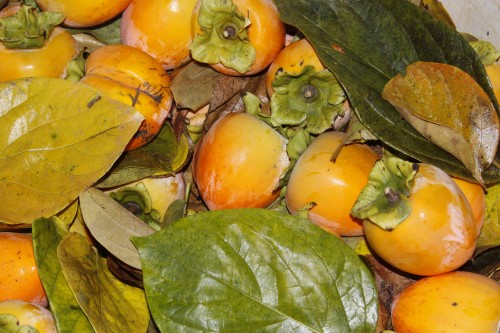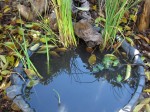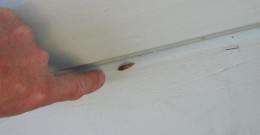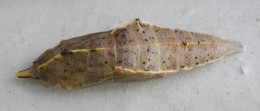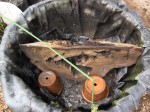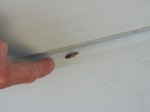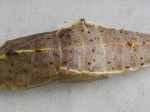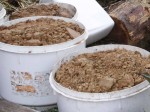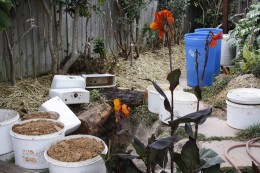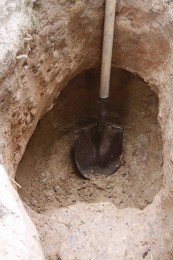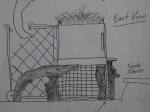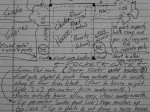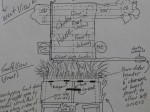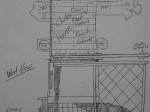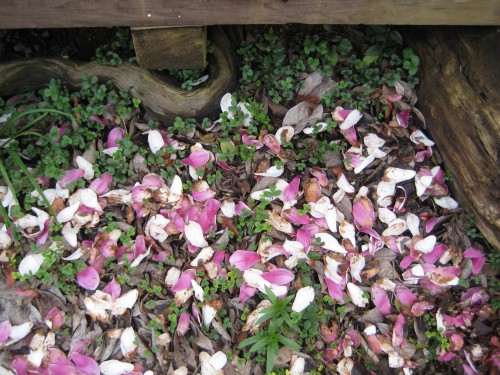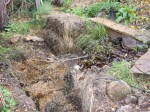
Garden Log:
1. Completed slate stacking to bring Zen Canyon Snake Pit’s ceiling flush with surrounding edges, which finished the installation of the habitat.
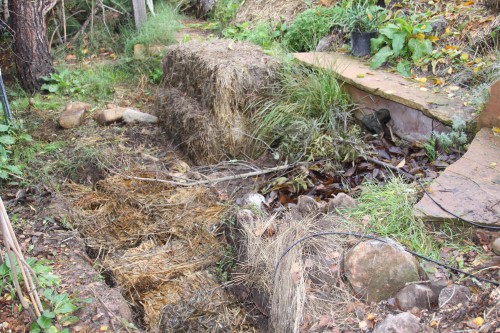
Zen Canyon Snake Pit covered over with soil, leaves and branches. The topmost slate of the slate-layered chamber will support a branch/twig/stump/log pile. That pile of organic material will be a thriving animal habitat as it breaks down, soon to be thrown onto the compost.
2. Dug out soil around irrigation zone #3’s last riser, in corner of back garden, to expose the tee connection. Threw the soil on top of Zen Canyon Snake Pit.
3. Cleaned magnolia leaves off spa deck and on pathways in back garden — thanks Glory! Leaves were dumped on top of fresh soil just thrown on ZCSP.
4. Began stick debris pile on top of Zen Canyon Snake Pit; sticks were from dying birch and miscellaneous piles around the yard.
5. Tossed old straw “tiles” into the trench that was the base of Rock Pile Planter.
6. Harvested persimmon fruit from neighbor’s tree. Thanx for the persimmons, Sunny!
You the Habitat Gardener:
1. What a great session in the garden today. Always a good day when an animal habitat is completed. All the ideas, the what-if’s, the how would that be’s, the plans and sketches, the gathering of materials, the actual work (imagine that!) to manipulate space and materials are over. Sometimes, finishing a habitat installation is anti-climatic, especially one that has been in my mind for months, maybe years. But today’s completion of Zen Canyon Snake Pit brings our back garden to a new stage.
Now that Zen Canyon is bridged over with slate, we can begin to create an organic debris pile (sticks, tree limbs, etc.) on top of it. Debris Pile Food Court is born! Where there once was a hole in the garden, there will be a through-fare for the wheelbarrow and a large-item compost pile, that is, a debris pile. We will keep the debris pile to one edge of the top of the snake pit and have a path for the wheel barrow over the other edge of it. The filled over “canyon” will become the base, or floor, of the debris pile, a new habitat in of itself.
Habitat stacking in the garden — the debris pile will shelter many microbes, insects, snails, slugs, spiders, and small animals feeding on them. Perhaps some of those critters will seek shelter below the debris pile, in the staking of slate and stone or in the two toilet tanks that make up the cracks and crevices of Zen Canyon Snake pit. And all the while the debris pile breaks down we will be making soil. Eventually most of the organic debris pile will be tossed on the nearby compost pile. We’re making soil!
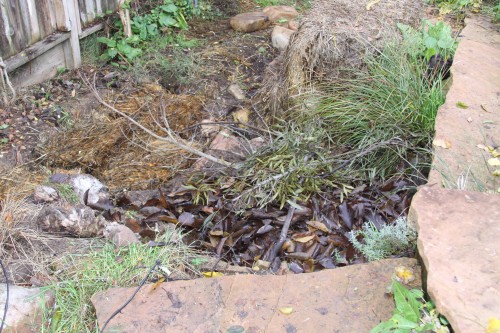
Organic garden debris, too large for the compost pile, will be piled to create the Debris Pile Food Court above Zen Canyon Snake Pit. Perhaps larger critters will live below ground and feed on the debris pile's smaller critters above.
2. Today began the creation of Debris Pile Food Court (Garden Log #2,3,4) — a pile of sticks , logs, stumps, tree limb sections piled above Zen Canyon Snake Pit. The debris pile will stand alone as an animal habitat, friendly to critters from microbes to insects to birds, amphibians, and reptiles. Maybe even a garden snake! Soil was thrown at the base of the pile to help sustain such biodiversity. Maybe some of those microbes working (breaking down) the wood pile will take shelter or food from the soil floor of the pile. Maybe that soil floor will be where the insects, snails, and slugs lay their eggs to keep the explosion of life going. And, that soil floor, rather than the slate floor is was, will also keep water available to further sustain animal life.
3. The magnolia leaves (Garden Log #3) cleared of our spa deck and off our garden slate pathways was thrown on top of Debris Pile Food Court’s soil base. Not great science, just wanted some place to put the leaves till our compost pile area is ready AND the leaves under the wood pile will add to the bio-diverse habitat of the now-planned soil-leaves-wood pile. Note that I said the leaves were only cleared away from the spa deck and the pathway; all other leaves will be left to break down on our small grass patch and in the beds of the back yard. What a mess! But that mess will provide great nutrition, shelter, and insulation for the soil microbes, larger critters, and plants ALL WINTER LONG. And be assured, by spring, the ground cover beds and grass will not only have recovered, but will be thriving and happy.
4. Used straw tiles (Garden Log #5) to fill up the base trench to the demolished Rock Pile Planter. Pulling off a few inches at a time from the end of the bale made nice thick, wet, heavy, partially-decayed slabs, or tiles, of straw. Perfect for filling in the thin trench. Eventually that straw will break down and leave a nutritious layer for the soil. Sure beats the adobe that was in the trench. And, in the meantime, the area has been leveled off and will have wheelbarrow access to the area.
5. Persimmon Harvest (Garden Log #6) is here. The beautiful fruit is ready to pick off of our neighbor’s tree. Enough fruit is left high in the tree, beyond reach with a 12-foot orchard ladder, to treat the birds of the neighborhood. No fruit goes unused — we will throw any harvested damaged fruit into the Earthworm Bin. Had some fun harvesting persimmons this year by using Nature-provided packaging. We used persimmon leaves between layers of fruit — the leaves provided a soft cushion AND are ripe with beauty. Will be fun to pack away some leaves as we pull out the fruit. Now you know what old phone books are good for; they have thin, absorbent paper that easily makes a flower or leaf press.
Competed installing one animal habitat and started another — what a great day!
Tony

